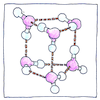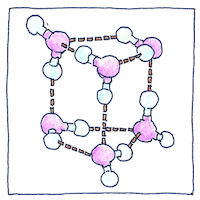Erasto Batholomeo Mpemba,
Denis G. Osborne
thermodynamics

|
Mpemba effect
Aristotle noted that water previously warmed cools sooner due to the conjunction of opposite qualities. Francis Bacon wrote that aqua parum tepida facilius conglacietur quam omnino frigida. René Descartes wrote that boiled water freezes more quickly than fresh water because boiling evaporates the least flexible particles, which makes sense since ice is a lot stiffer. Joseph Black confirmed that boiled water freezes faster and added that stirring causes immediate freezing. But the effect is named after Erasto Mpemba who merely asked the question “Why?” Denis Osborne tested and confirmed the proposition but didn’t answer the question, although Mpemba and Osborne ruled out evaporation and the effect of dissolved gases in the water.
Dad said
Some have said evaporation carries away both heat and water mass. Some have said evaporation promotes convection to stir the water for more rapid cooling. Some have said that warm water has less dissolved gas, promoting convection. Some have said colder water freezes from the top, reducing heat loss from the bottom. Some have said that warmer water melts insulating frost on the floor of the freezer. Some have said warm water has weaker hydrogen bonds, making it easier, I guess, to rearrange into crystals. Some have said warm water has more strong hydrogen bonds, promoting the nucleation of hexagonal ice crystals. Some have said warm water has more water hexamer states, but what are those? Some have said cold water is more easily supercooled, which works against freezing. Some have said it’s all about entropy. My dad said it’s due to thermal expansion matching the expansion of freezing ice. He said cold water needs to expand more to match the expansion needed by the ice as it freezes. Some have said that the Mpemba effect is balony. They said freezing depends on where you place the thermometer.
Monomers, dimers, and hexamers
Not trimers, tetramers, pentamers, heptamers, octamers, nonamers, or decamers? Water monomers form dimers and hexamers, and I want to ask what are dimers and hexamers? A simple explanation might be near at hand, whereupon I find that hexamers have different isomers. Liquid water is a gloriously unstable polymer. Actually, it forms trimers, tetramers, and pentamers, but one source claims that its hexamers are its smallest three-dimensional isomers, and the lowest-energy hexamer isomers are the cage, prism, book, boat, and chair. And, by the way, there are seventeen or more different forms of ice. Not a simple problem.



The most common non-amorphous ice is ice Ih, with a hexagonal crystalline structure. Ice Ic is cubic ice. Ice II is a rhombohedral crystal. Ice III is a tetragonal crystal. And so forth! Yes, there is an ice IX, they say; it’s a tetragonal phase of ice III.
See also in The book of science:
Readings in wikipedia: